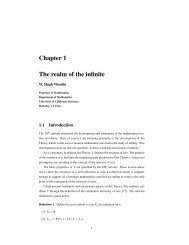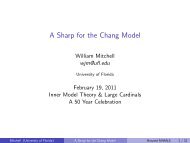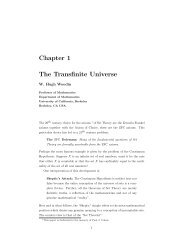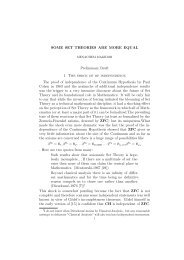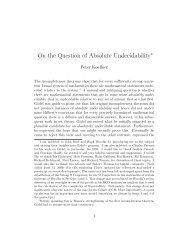The Continuum Hypothesis - Logic at Harvard
The Continuum Hypothesis - Logic at Harvard
The Continuum Hypothesis - Logic at Harvard
Create successful ePaper yourself
Turn your PDF publications into a flip-book with our unique Google optimized e-Paper software.
an axiom V=L Ω with the following fe<strong>at</strong>ures: First, V=L Ω is “effectivelycomplete.” Second, V=L Ω is comp<strong>at</strong>ible with all large cardinal axioms.Thus, on this scenario, the ultim<strong>at</strong>e theory would be the (open-ended) theoryZFC+V=LΩ +LCA, where LCAis a schema standing for“largecardinalaxioms.” <strong>The</strong> large cardinal axioms will c<strong>at</strong>ch instances of Gödelian independenceand the axiom V=L Ω will capture the remaining instances of independence.This theory would imply CH and settle the remaining undecidedst<strong>at</strong>ements. Independence would cease to be an issue.It turns out, however, th<strong>at</strong> there are other candid<strong>at</strong>e axioms th<strong>at</strong> sharethese fe<strong>at</strong>ures, and so the spectre of pluralism reappears. For example, thereare axioms V=L Ω S and V=LΩ (∗). <strong>The</strong>se axioms would also be “effectivelycomplete” and comp<strong>at</strong>ible with all large cardinal axioms. Yet they wouldresolve various questions differently than the axiom V=L Ω . For example,the axiom, V=L Ω (∗)would imply ¬CH. How, then, is one to adjudic<strong>at</strong>ebetween them?Further Reading: For an introduction to inner model theory see Mitchell(2010) and Steel (2010). For more on the recent developments <strong>at</strong> the level ofone supercompact and beyond see Woodin (2011b).7 <strong>The</strong> Structure <strong>The</strong>ory of L(V λ+1 )This brings us to the second global approach, one th<strong>at</strong> promises to select thecorrect axiom from among V=L Ω , V=L Ω S , V=LΩ (∗), and their variants. Thisapproach is based on the remarkable analogy between the structure theoryof L(R) under the assumption of AD L(R) and the structure theory of L(V λ+1 )under the assumption th<strong>at</strong> there is an elementary embedding from L(V λ+1 )into itself with critical point below λ. This embedding assumption is thestrongest large cardinal axiom th<strong>at</strong> appears in the liter<strong>at</strong>ure.<strong>The</strong> analogy between L(R) and L(V λ+1 ) is based on the observ<strong>at</strong>ion th<strong>at</strong>L(R) is simply L(V ω+1 ). Thus, λ is the analogue of ω, λ + is the analogueof ω 1 , and so on. As an example of the parallel between the structure theoryof L(R) under AD L(R) and the structure theory of L(V λ+1 ) under theembedding axiom, let us mention th<strong>at</strong> in the first case, ω 1 is a measurablecardinal in L(R) and, in the second case, the analogue of ω 1 —namely, λ + —isa measurable cardinal in L(V λ+1 ). This result is due to Woodin and is justone instance from among many examples of the parallel th<strong>at</strong> are contained34





